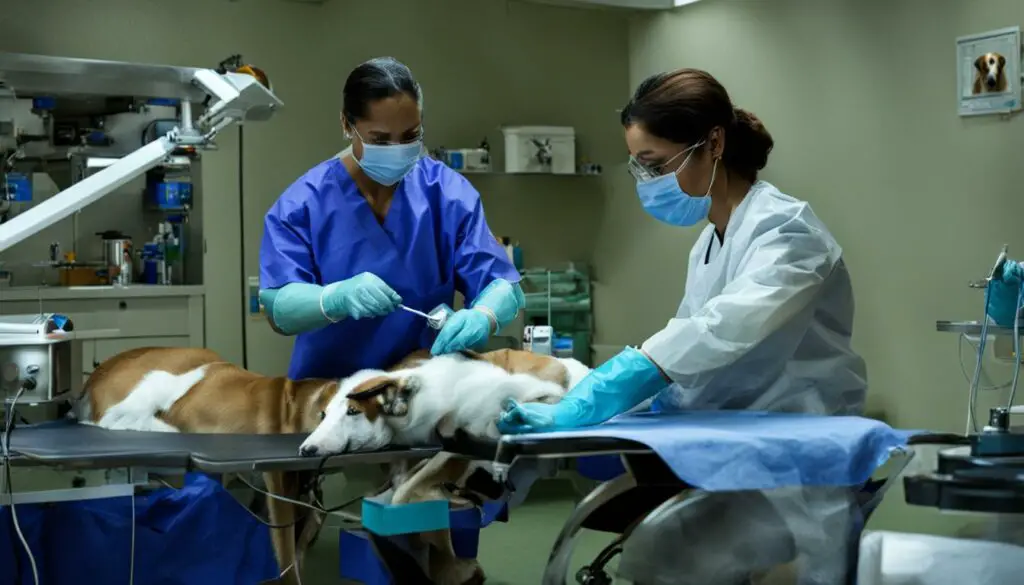As a pet owner, I understand how challenging it can be when you find yourself unable to afford ACL surgery for your beloved dog. The cost of veterinary care can sometimes feel overwhelming, leaving you feeling helpless and unsure of how to provide the necessary treatment for your furry companion. However, there are various options and resources available to help alleviate the financial burden and ensure that your dog receives the care they need.
In this article, I will explore different avenues for affordable pet surgery options and alternative treatments for ACL injury in dogs. From low-cost ACL surgery options and financial assistance programs to cost-effective veterinary care and discounted services, we will cover a range of possibilities. It’s important to remember that you are not alone in this journey, and there are resources and solutions out there to support you and your furry family member.
Key Takeaways:
- Not being able to afford ACL surgery for your dog can be challenging, but there are options available to help.
- Explore low-cost ACL surgery options and financial assistance programs to alleviate the financial burden.
- Consider alternative treatments and cost-effective veterinary care for ACL injury in dogs.
- Consult with a veterinarian to discuss your options and find the best solution for your dog’s well-being.
- Remember that there are resources and support available to help you navigate this difficult situation.
Treating ACL Tears Without Surgery – Conservative Management
When faced with the financial burden of ACL surgery for their dogs, pet owners may explore conservative management as a non-surgical treatment option. This approach focuses on promoting healing and strengthening the injured leg through a combination of restricted activity, supplements and medication, and physical therapy.
Conservative management involves limiting the dog’s physical activity to allow the torn ACL to heal. This may include crate rest and leash walks instead of high-intensity exercise. By reducing the stress on the injured leg, conservative management aims to alleviate pain and promote natural healing over time.
In addition to restricted activity, pet owners may provide supplements and medication to support the healing process. Common supplements for ACL tears include glucosamine and chondroitin, which help to promote joint health and reduce inflammation. Non-steroidal anti-inflammatory drugs (NSAIDs) may also be prescribed to manage pain and swelling.
Working with a physical therapist experienced in canine rehabilitation is an essential aspect of conservative management. Through a customized program of exercises and manual treatments, physical therapy can help improve range of motion, strengthen the injured leg, and promote overall recovery. Modalities such as hydrotherapy and cold laser therapy may also be incorporated to further enhance healing and reduce pain.
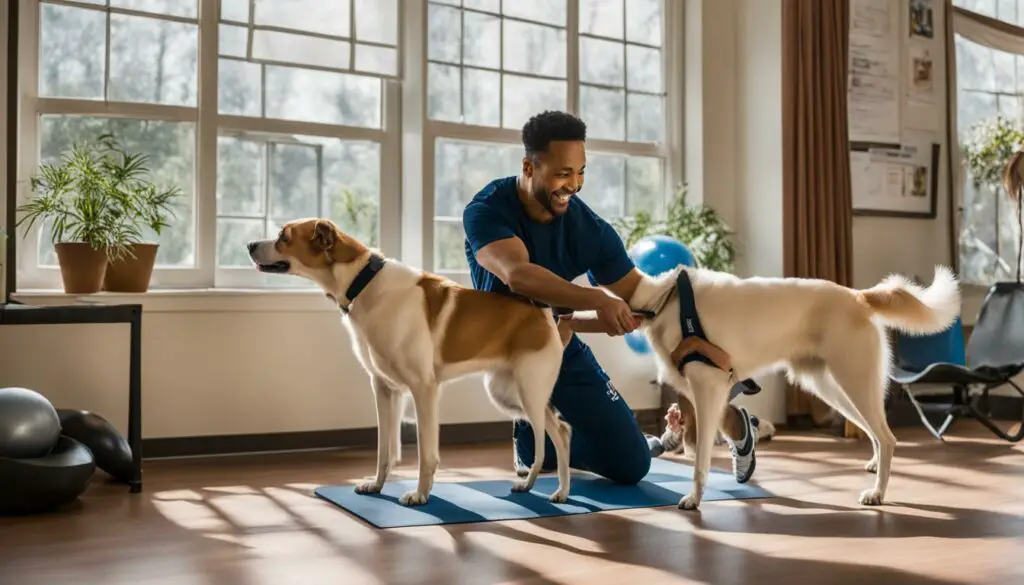
Conservative management can be a viable alternative for dogs whose owners cannot afford ACL surgery. It provides a non-surgical approach to treating ACL tears, focusing on healing, pain reduction, and improving mobility. However, it is important to consult with a veterinarian to determine if conservative management is suitable for your dog’s specific condition.
Physical Therapy for ACL Injuries in Dogs
Physical therapy is a crucial component of the conservative management approach for treating ACL injuries in dogs. It involves a combination of exercises, manual treatments, and specialized modalities to aid in the rehabilitation and recovery process. The goal of physical therapy is to improve mobility, reduce pain, and promote healing in the injured leg.
Benefits of Physical Therapy for ACL Injury
Physical therapy offers several benefits for dogs with ACL injuries. It helps increase range of motion, strengthen muscles, and improve overall joint stability. Through targeted exercises and techniques, physical therapy can also help reduce inflammation, alleviate pain, and prevent secondary complications.
Hydrotherapy and Cold Laser Therapy
Two commonly used modalities in physical therapy for ACL injuries are hydrotherapy and cold laser therapy. Hydrotherapy involves exercises performed in a water environment, which reduces stress on the injured leg and provides buoyancy for easier movement. Cold laser therapy, on the other hand, uses low-intensity lasers to stimulate cellular healing and reduce inflammation in the affected area.
Rehabilitation Exercises and Techniques
Physical therapists use a variety of rehabilitation exercises and techniques to aid in the recovery of dogs with ACL injuries. These may include range of motion exercises, strength training exercises, balance and proprioception exercises, and manual techniques such as massage and stretching. Each dog’s therapy plan is tailored to their specific needs and progress.
| Rehabilitation Exercises for ACL Tear Recovery | Benefits |
|---|---|
| Passive Range of Motion Exercises | Help maintain joint flexibility and prevent stiffness. |
| Weight-Shifting and Weight-Bearing Exercises | Improve balance, stability, and weight-bearing capacity of the affected leg. |
| Therapeutic Exercises | Strengthen muscles supporting the injured leg and promote overall joint stability. |
| Proprioception Exercises | Enhance body awareness and improve coordination and joint position sense. |
Physical therapy plays a vital role in the conservative management of ACL injuries in dogs. It not only helps improve the dog’s mobility and overall well-being but also provides a non-surgical option for pet owners who cannot afford ACL surgery. By working closely with a physical therapist and following a tailored rehabilitation plan, dogs can experience significant improvement and a better quality of life.
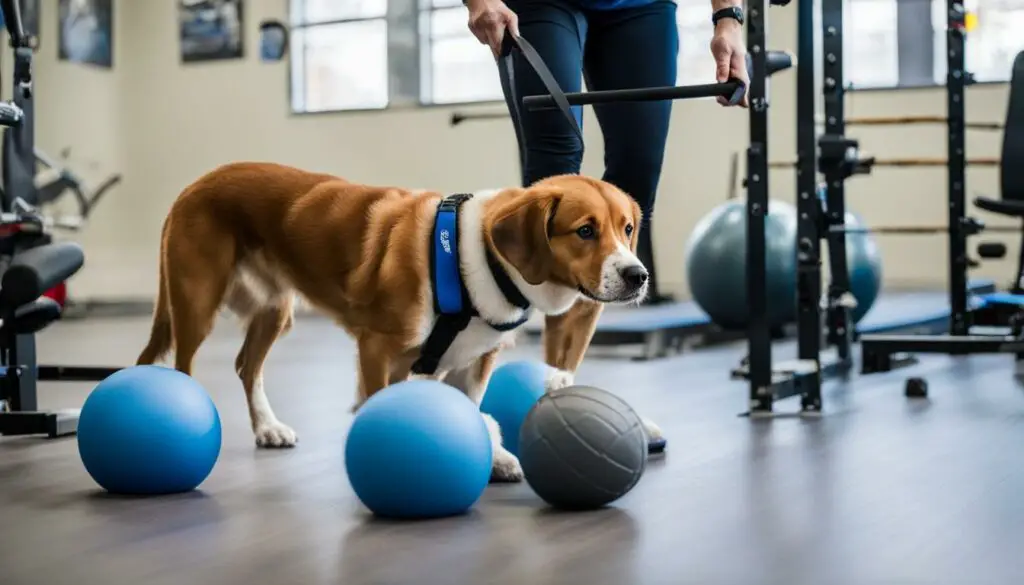
Dietary and Weight Management for Dogs with ACL Injuries
Maintaining a proper diet and managing your dog’s weight are crucial aspects of the treatment plan for ACL injuries. A balanced and nutritious diet can support the healing process and optimize your dog’s overall health. While each dog’s dietary needs may vary based on factors such as age, breed, and activity level, there are general guidelines to follow.
Firstly, it’s important to consult with your veterinarian to determine the most suitable diet for your dog with an ACL injury. They may recommend a specific brand or type of dog food that supports joint health and provides the necessary nutrients for recovery. Look for dog foods that are rich in protein, healthy fats, and beneficial antioxidants.
In addition to a high-quality dog food, your veterinarian may suggest incorporating supplements into your dog’s diet. Supplements such as glucosamine and chondroitin can help support joint health and reduce inflammation. Omega-3 fatty acids and turmeric are also natural anti-inflammatory agents that can aid in the recovery process. Remember to always follow the recommended dosage and consult with your veterinarian before introducing any new supplements.
| Nutritional Support for ACL Injury in Dogs | Benefits |
|---|---|
| Protein | Supports muscle repair and recovery |
| Healthy fats | Provides energy and supports joint health |
| Antioxidants | Helps reduce inflammation and supports immune function |
| Glucosamine and chondroitin | Support joint health and reduce pain |
| Omega-3 fatty acids | Natural anti-inflammatory properties |
| Turmeric | Helps reduce inflammation |
When it comes to weight management, maintaining a healthy weight is essential to reduce stress on the injured leg. Excess weight can exacerbate the strain on the ACL and impede the healing process. Your veterinarian can guide you on the ideal weight range for your dog and provide recommendations on portion control and calorie intake.
Incorporating regular exercise into your dog’s routine can also help with weight management and overall joint health. However, it’s crucial to follow your veterinarian’s recommendations regarding exercise restrictions and gradually increase activity levels as your dog recovers.
References:
- “Feeding Your Dog After Orthopedic Surgery.” VCA Animal Hospitals, https://vcahospitals.com/know-your-pet/feeding-your-dog-after-orthopedic-surgery.
- “Dietary Considerations for Dogs with Orthopedic Conditions.” Cummings Veterinary Medical Center at Tufts University, https://vetnutrition.tufts.edu/2019/03/dietary-considerations-for-dogs-with-orthopedic-conditions/.
Alternative Treatments for ACL Injuries in Dogs
When it comes to treating ACL injuries in dogs, there are alternative therapies that can be explored alongside traditional treatments. These alternative treatments offer holistic approaches and natural remedies that may provide added benefits for your dog’s healing process.
Chiropractic care is one alternative treatment option for dogs with ACL injuries. It focuses on the alignment of the spine and musculoskeletal system to promote overall wellness and healing. Chiropractors trained in animal care can help restore balance and alleviate pain in dogs with ACL injuries.
Acupuncture is another alternative treatment that can be beneficial for dogs with ACL injuries. This ancient Chinese practice involves inserting thin needles into specific points on the body to stimulate healing and relieve pain. Acupuncture can help reduce inflammation and improve blood flow to the injured leg, aiding in the recovery process.
| Treatment | Description |
|---|---|
| Chiropractic Care | Focuses on aligning the spine and musculoskeletal system to promote healing and alleviate pain. |
| Acupuncture | Involves inserting thin needles into specific points on the body to stimulate healing and relieve pain. |
It’s important to note that alternative treatments like chiropractic care and acupuncture should be performed by qualified professionals who specialize in veterinary care. Always consult with a veterinarian experienced in these modalities to ensure they are appropriate for your dog’s specific condition and overall well-being.
By exploring alternative treatments alongside traditional options, you can provide comprehensive care for your dog’s ACL injury and support their overall healing process.
Financial Assistance Programs for Dog ACL Surgery
When faced with the financial burden of ACL surgery for your dog, there are various financial assistance programs available to help ease the cost. These programs offer grants, discounted services, and payment plans to support pet owners in need. By exploring these options, you can ensure that your dog receives the necessary surgical care without the strain on your finances.
Table: Financial Assistance Programs for Dog ACL Surgery
| Program | Description | Requirements | Availability |
|---|---|---|---|
| XYZ Animal Foundation | Offers grants for dog ACL surgery | Proof of financial need, application process | Nationwide |
| ABC Veterinary Clinic | Discounted ACL surgery for eligible pet owners | Income verification, application approval | Local community |
| 123 Pet Care Charity | Financial assistance for dog ACL surgery | Application, approval process | Nationwide |
| Veterinary Assistance Fund | Low-cost ACL surgery for dogs in need | Proof of financial need, application | Various regions |
Additionally, veterinary assistance programs and charity funds can provide support for dog owners seeking ACL surgery. These resources may offer financial aid, fundraising opportunities, or access to low-cost veterinary services. Researching and reaching out to local organizations and non-profits dedicated to animal welfare can uncover valuable financial support options.
It’s important to note that each program may have specific requirements and availability, so it’s essential to thoroughly review the application process and eligibility criteria. By exploring these financial assistance programs and resources, you can find the help you need to ensure your dog receives the ACL surgery they require.

CareCredit and Pet Insurance for ACL Surgery
When it comes to affording ACL surgery for your dog, there are two options that can help ease the financial burden: CareCredit and pet insurance. CareCredit is a healthcare credit card that can be used for a variety of medical expenses, including veterinary care. It offers a financing option that allows you to pay for the surgery over time, making it more manageable for your budget. With CareCredit, you can ensure that your dog receives the necessary ACL surgery without having to worry about a large upfront cost.
Pet insurance is another valuable resource to consider. This type of insurance helps cover the cost of veterinary care, including ACL surgery. By paying a monthly premium, you can have peace of mind knowing that your dog’s medical expenses will be covered. Depending on the policy you choose, pet insurance can help offset a significant portion of the surgery costs, making it a worthwhile investment.
Before making a decision, it’s important to carefully review the terms and conditions of both CareCredit and pet insurance policies. Consider factors such as interest rates, coverage limits, deductibles, and waiting periods. Additionally, consult with your veterinarian to understand the specific requirements and recommendations for ACL surgery and how they align with the options provided by CareCredit and pet insurance.
Comparing CareCredit and Pet Insurance for ACL Surgery Costs
| Aspect | CareCredit | Pet Insurance |
|---|---|---|
| Payment Method | Healthcare credit card | Monthly premium |
| Financing Options | Flexible repayment terms | Varies depending on the policy |
| Coverage | Specifically for medical expenses | Medical expenses, including ACL surgery, based on the chosen policy |
| Interest Rates | Varies depending on the promotional offer and creditworthiness | Varies depending on the insurance provider and policy |
| Waiting Period | N/A | Typically, there is a waiting period before coverage begins |
| Policy Limitations | May have a credit limit | May have coverage limits, deductibles, and exclusions |
Choosing between CareCredit and pet insurance ultimately depends on your financial situation, the specifics of the ACL surgery recommended for your dog, and the coverage options available to you. It’s essential to carefully evaluate the terms and consult with your veterinarian to determine which option best suits your needs. By exploring these financial resources, you can ensure that your dog receives the necessary ACL surgery without compromising their well-being due to financial constraints.
Local Resources and Charitable Organizations
When facing the challenge of affording ACL surgery for your dog, it’s essential to explore local resources and charitable organizations that can provide support. These organizations understand the financial burden that pet owners may face and are dedicated to helping ensure that dogs receive the necessary medical care they need.
One option is to reach out to local animal shelters or rescue organizations in your area. They may have programs or partnerships with veterinary clinics that offer discounted services for pet owners in need. These organizations often have a network of resources and can help guide you towards affordable options for ACL surgery.
Additionally, there are non-profit organizations specifically focused on providing financial assistance for pet surgeries. These organizations may offer grants, fundraising opportunities, or low-cost veterinary services to help alleviate the financial burden of ACL surgery. Researching and reaching out to these organizations can provide valuable support and resources.
In some communities, there are also community funds or foundations dedicated to helping pet owners with veterinary expenses. These funds may be supported by local businesses, community members, or charitable donations. They can provide financial assistance or guidance on accessing affordable veterinary care for ACL surgery.
Local Resources and Charitable Organizations
| Name | Description | Contact Information |
|---|---|---|
| Animal Shelter XYZ | Offers discounted veterinary services for pet owners in need | Phone: 123-456-7890 Email: [email protected] |
| Pet Surgery Assistance Foundation | Provides financial assistance and grants for pet surgeries | Website: www.petsurgeryassistancefoundation.org |
| Community Pet Care Fund | Dedicated to helping pet owners with veterinary expenses in the community | Phone: 987-654-3210 Email: [email protected] |
By taking advantage of local resources and reaching out to charitable organizations, you can find the support you need to afford ACL surgery for your dog. These organizations are committed to helping pet owners in need and can guide you towards affordable options and financial assistance. Remember to research, connect, and ask for help when facing financial hurdles in providing the best care for your furry companion.

Crowdfunding for Dog ACL Surgery
When faced with the financial burden of ACL surgery for your dog, crowdfunding can be a viable option to help raise the necessary funds. Online platforms like GoFundMe provide a convenient and accessible way to reach out to friends, family, and even strangers who may be willing to contribute to your dog’s surgery expenses. By creating a compelling campaign and sharing your pet’s story, you can engage potential donors and inspire them to support your cause.
“Crowdfunding can be a powerful tool to rally the community around your dog’s healthcare needs. By leveraging the power of social media and personal connections, you can raise awareness and funds for your dog’s ACL surgery.”
When setting up a crowdfunding campaign, be sure to clearly outline the financial goal and how the funds will be used. Provide regular updates to donors, expressing gratitude and showing the progress of your dog’s recovery. Share the campaign on social media platforms, in local pet-related groups, and with friends and family. Remember to include engaging visuals, such as photos or videos of your dog, to create an emotional connection with potential supporters.
Benefits of Crowdfunding for Dog ACL Surgery
- Financial Support: Crowdfunding can help alleviate the financial burden of ACL surgery by generating funds from a wide network of supporters.
- Community Engagement: By sharing your dog’s story and the need for surgery, you can engage and rally your community, creating a sense of togetherness and support.
- Emotional Support: Crowdfunding allows you to connect with others who have experienced similar situations, providing a platform for emotional support and understanding.
- Increased Awareness: Through sharing your campaign on social media, you can raise awareness about ACL injuries in dogs and the financial challenges faced by pet owners.
Remember to express sincere appreciation to all who contribute to your dog’s crowdfunding campaign. Their generosity and support can make a significant difference in your pet’s quality of life and overall well-being.

Resources for Non-Surgical Options
If you’re exploring non-surgical options for treating your dog’s ACL injury, there are resources available to provide guidance and support. These resources can help you make informed decisions about your dog’s care and ensure that you have access to the information you need.
Conservative Management Resources
Conservative management is a non-surgical approach to treating ACL injuries in dogs. It involves restricting activity, providing supplements, and working with a physical therapist. There are various resources available that provide detailed guides and instructions on how to implement conservative management for your dog’s specific case. These resources can guide you through the process of managing your dog’s injury and promoting healing without surgery.
Physical Therapy Resources
Physical therapy plays a crucial role in the conservative management of ACL injuries in dogs. There are resources available that provide information on specific exercises, manual treatments, and modalities like hydrotherapy and cold laser therapy. These resources can help you understand the benefits of physical therapy and provide guidance on how to perform exercises and treatments at home.
Non-Surgical Treatment Guides
For pet owners who are considering non-surgical options, there are comprehensive treatment guides available that cover a range of alternative treatments for ACL injuries in dogs. These guides can provide detailed information on holistic approaches like chiropractic care and acupuncture, as well as natural remedies and supplements. They can help you understand the effectiveness and safety of these treatments and guide you in making decisions about your dog’s care.
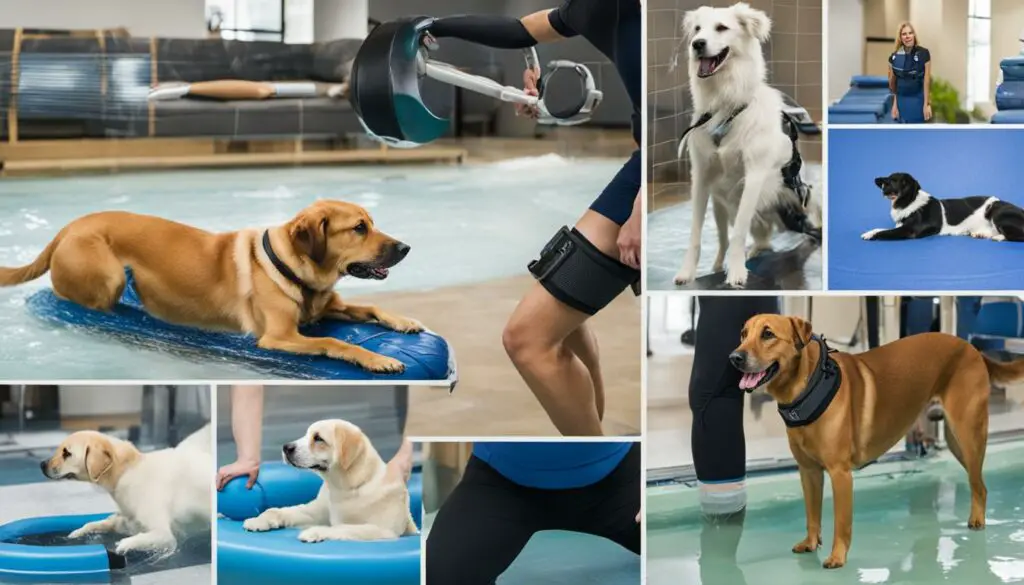
By utilizing these resources, you can gain a better understanding of the non-surgical options available for treating your dog’s ACL injury. Remember to always consult with a veterinarian to ensure you’re making the best decisions for your dog’s health and well-being.
The Importance of Seeking Veterinary Advice
When it comes to your dog’s ACL injury, seeking veterinary advice is of utmost importance. As a dog owner, it can be tempting to try and navigate the treatment options on your own, but a veterinarian’s expertise is invaluable in ensuring the best care for your furry friend.
Consulting a veterinarian allows for a proper assessment of the severity of the injury and enables them to provide specific treatment recommendations tailored to your dog’s individual needs. They have the knowledge and experience to guide you through the various options available, whether it’s surgery, conservative management, or alternative treatments.
“A veterinarian’s professional guidance can help you make informed decisions about the best course of action for your dog’s ACL injury.”
Additionally, a veterinarian can offer guidance on managing the financial aspect of the treatment. They understand the financial strain that costly procedures like ACL surgery can have on pet owners and can provide information on financial assistance programs, pet insurance options, and local resources that may be available to you.
By seeking veterinary advice, you are ensuring that your dog receives the most appropriate and effective treatment for their ACL injury. A veterinarian’s expertise, coupled with their genuine care for your pet’s well-being, will give you peace of mind knowing that you are providing the best possible care for your furry companion.
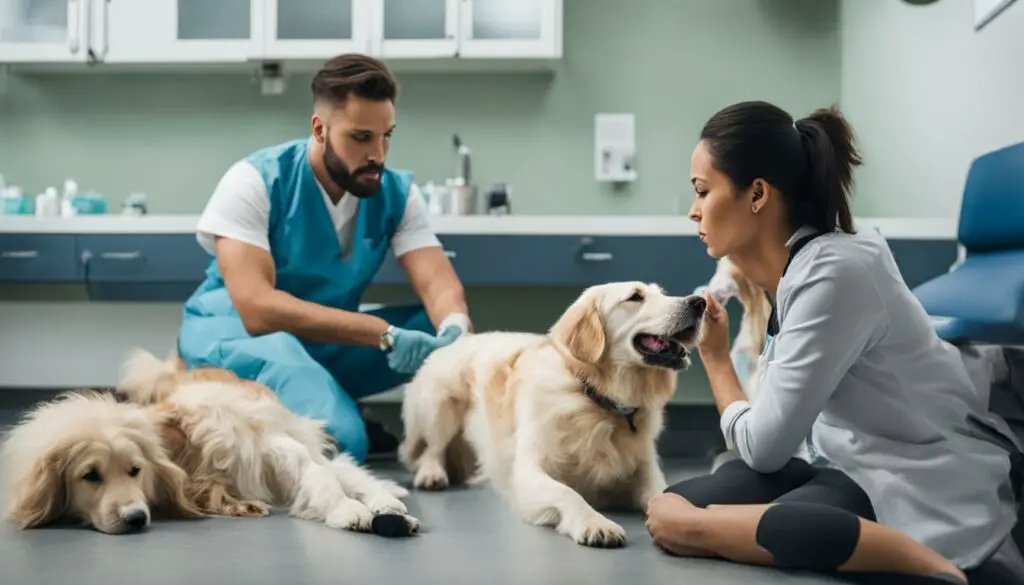
Planning and Preparation for Dog ACL Surgery
When it comes to preparing for dog ACL surgery, there are several steps you can take to ensure a smooth and successful procedure. Prior to the surgery, it is important to follow the pre-operative care guidelines provided by your veterinarian. This may include restrictions on food and water intake before the surgery, as well as any necessary medications that need to be administered.
Creating a safe and comfortable post-operative environment for your dog is crucial for their recovery. Prepare a quiet and cozy space where your dog can rest and limit their activity during the healing process. It may be helpful to have a designated area with soft bedding, away from other pets and potential sources of stress.
Following the surgery, your dog will require post-operative care and monitoring. This may include administering medications as directed, such as pain relievers or antibiotics, and keeping a close eye on the surgical site for any signs of infection or complications. Additionally, your veterinarian will provide guidelines for gradually reintroducing exercise and physical therapy to help your dog recover and regain strength in their leg.
| Recovery Tips for Dog ACL Surgery |
|---|
| 1. Provide a calm and quiet environment for your dog’s recovery. |
| 2. Follow all post-operative instructions provided by your veterinarian. |
| 3. Administer medications as directed and monitor the surgical site for any signs of infection. |
| 4. Gradually reintroduce exercise and physical therapy under the guidance of your veterinarian. |
By properly planning and preparing for your dog’s ACL surgery, you can help optimize their chances of a successful recovery. Remember to consult with your veterinarian throughout the process to ensure you are providing the best possible care for your beloved companion.
Support and Care for Your Dog During Recovery
After your dog undergoes ACL surgery, it’s important to provide the necessary support and care during their recovery period. This includes managing their pain, following a rehabilitation plan, and ensuring a comfortable environment for their healing process.
Pain management is a crucial aspect of post-operative care. Your veterinarian will prescribe medication to help alleviate your dog’s pain and discomfort. It’s important to administer the medication as directed and monitor your dog’s response to ensure they are comfortable throughout the recovery process.
Rehabilitation exercises are essential for promoting healing and regaining strength in the injured leg. Your veterinarian or a physical therapist may provide a specific exercise plan tailored to your dog’s needs. These exercises may include gentle range of motion movements, controlled weight-bearing exercises, and gradual increase in activity level as the healing progresses.
Creating a comfortable and secure environment for your dog during recovery is also vital. Provide a quiet and low-stress space for your dog to rest and heal. Consider using a crate or a designated area with soft bedding, away from other pets or children, to ensure a calm and safe environment for their recovery.
Monitoring your dog’s progress is essential to identify any signs of complications or setbacks. Keep a close eye on the surgical site for any swelling, redness, or discharge. Report any concerns or changes in your dog’s behavior to your veterinarian promptly. Regular follow-up appointments with your veterinarian will help track your dog’s healing progress and determine if any adjustments to their care plan are needed.
By providing the necessary support and care during your dog’s recovery period, you can help ensure a successful ACL surgery outcome and promote their overall well-being.

Conclusion
As a pet owner, facing financial constraints when it comes to affording ACL surgery for your dog can be overwhelming. However, there are various options and resources available to help you navigate this difficult situation and ensure that your furry friend receives the necessary care.
If surgery is not feasible due to financial limitations, conservative management can be a viable alternative. This approach includes restricting your dog’s activity, providing supplements and medication, and working with a physical therapist to promote healing and strengthen the injured leg.
In addition to conservative management, there are alternative treatments such as chiropractic care and acupuncture that can be explored with the guidance of an experienced veterinarian. Dietary and weight management, along with proper nutrition, play an important role in supporting the healing process.
Financial assistance programs, pet insurance, and crowdfunding platforms like GoFundMe can also provide much-needed support. Local resources and charitable organizations in your community may offer grants, discounted services, or access to low-cost veterinary care.
Remember, it’s crucial to consult with a veterinarian throughout this process. They can provide professional guidance, assess the severity of the injury, and help you make informed decisions about your dog’s care. By exploring the available options and seeking support, you can ensure the best possible outcome for your beloved pet.
FAQ
What is conservative management for ACL tears in dogs?
Conservative management is a non-surgical approach to treating ACL tears in dogs that involves restricting activity, providing supplements and medication, and working with a physical therapist to promote healing and strengthen the injured leg.
How does physical therapy help with ACL injuries in dogs?
Physical therapy plays a crucial role in the conservative management of ACL injuries in dogs by improving mobility, reducing pain, and promoting healing in the injured leg. It includes exercises, manual treatments, and modalities like hydrotherapy and cold laser therapy.
Why is diet and weight management important for dogs with ACL injuries?
Maintaining a healthy diet and managing your dog’s weight can help reduce stress on the injured leg and support overall healing. Your veterinarian may recommend specific dietary changes or supplements to aid in the recovery process.
Are there alternative treatments for ACL injuries in dogs?
Yes, there are alternative therapies that can be explored for ACL injuries in dogs, including holistic approaches like chiropractic care and acupuncture, as well as natural remedies and supplements. It’s important to consult with a veterinarian experienced in these modalities before considering them for your dog.
Are there financial assistance programs available for dog ACL surgery?
Yes, there are financial assistance programs available to help pet owners afford ACL surgery for their dogs. These programs may offer grants, discounted services, or payment plans to ease the financial burden. Researching and applying for these programs can provide much-needed support during a challenging time.
How can CareCredit and pet insurance help with ACL surgery expenses?
CareCredit is a healthcare credit card that can be used for pet expenses, including ACL surgery. It provides a financing option for pet owners who cannot afford the upfront cost. Additionally, pet insurance can help cover the expenses of ACL surgery and other veterinary care.
Are there local resources and charitable organizations that can help with dog ACL surgery?
Many local communities have resources and charitable organizations dedicated to helping pet owners afford necessary medical treatments like ACL surgery. These organizations may provide financial aid, fundraising opportunities, or access to low-cost veterinary services. Researching and reaching out to these local resources can provide valuable support.
Can crowdfunding be used to raise funds for dog ACL surgery?
Yes, crowdfunding platforms like GoFundMe can be a valuable tool for raising funds for dog ACL surgery. By sharing your pet’s story and the financial need, you can reach out to friends, family, and even strangers who may be willing to contribute to your cause.
Are there resources available for non-surgical options for ACL injuries in dogs?
Yes, there are resources available to provide guidance and support for non-surgical options for treating ACL injuries in dogs. These resources may include books, articles, online forums, and professional associations dedicated to non-surgical treatment options.
Why is it important to seek veterinary advice for a dog’s ACL injury?
It is crucial to seek veterinary advice when dealing with a dog’s ACL injury. A veterinarian can assess the severity of the injury, provide specific treatment recommendations, and offer guidance on managing the financial aspect. They can also help determine if non-surgical options are suitable for your dog’s condition and overall well-being.
How should I plan and prepare for dog ACL surgery?
If you decide that ACL surgery is the best option for your dog, proper planning and preparation are essential. This includes pre-operative care, arranging for post-operative care, and following the veterinarian’s instructions for the recovery period. Being well-prepared will help ensure a smoother surgery and recovery process for your dog.
How can I support and care for my dog during the recovery phase after ACL surgery?
Supporting and caring for your dog during the recovery phase after ACL surgery is crucial. This may involve administering medication, following a rehabilitation plan, providing a comfortable and secure environment, and closely monitoring your dog’s progress. Proper care and attention will aid in the healing process and help your dog regain mobility.
What are the options if I can’t afford ACL surgery for my dog?
While not being able to afford ACL surgery for your dog can be challenging, there are various options available to provide the necessary care. From conservative management and physical therapy to financial assistance programs and crowdfunding, pet owners can explore different avenues to ensure their dog’s well-being. Consulting with a veterinarian and utilizing resources can help guide you in making the best decisions for your beloved pet.

